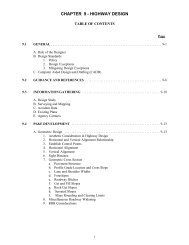Baltimore-Washington Parkway Widening Feasibility Study
Baltimore-Washington Parkway Widening Feasibility Study
Baltimore-Washington Parkway Widening Feasibility Study
- No tags were found...
Create successful ePaper yourself
Turn your PDF publications into a flip-book with our unique Google optimized e-Paper software.
<strong>Baltimore</strong>-<strong>Washington</strong> <strong>Parkway</strong> <strong>Widening</strong> <strong>Feasibility</strong> <strong>Study</strong>Alternatives DefinitionMinimize impacts on other Federal properties.Consider not only vehicle but also person-throughput on the corridor.Maintain limited access nature of the <strong>Parkway</strong>Public input that was used as consideration in the alternatives development included the following:Widen to the inside versus the outside as outside widening has the potential to impact homesand more trees.MD 410/Riverdale Road: improvements at the interchange including longer access lanes.I-495: better merge and exit lanes.MD 197: more highway width and improve traffic flow at the interchange, mainly in thesouthbound direction.3.2<strong>Parkway</strong>AlternativesAs a result of the stakeholder input, a total of five potential parkway improvement conceptualalternatives were identified. The descriptions of each potential widening concept are as follows.1. No-Build: No widening of the <strong>Parkway</strong>.2. Build 1: <strong>Widening</strong> of the mainline to the inside right-of-way.3. Build 2: <strong>Widening</strong> of mainline to the outside right-of-way.4. Build 3: Combination of inside and outside mainline widening.5. Build 4: Use of existing shoulders for the third lane.The No-Build Alternative represents those multimodal transportation system improvements included inthe currently adopted <strong>Baltimore</strong> and <strong>Washington</strong> Metropolitan Area Consolidated Long Range Plans ofregional significance in the study area. These transportation improvements include completion ofwidening along the Maryland SHA-owned portion of the B-W <strong>Parkway</strong> to create a six-lane cross section,the Purple Line fixed guideway transit facility between Bethesda and New Carrollton, and the Inter-County Connector toll-road between the I-270 and I-95 corridors.Two separate design options were also identified for each of the widening alternatives based on thedifferent design standards used by NPS and Maryland SHA. These standards were assessed inconsideration of the analysis of potential impairment to the NPS-owned and managed B-W <strong>Parkway</strong>facility. The purposes of a <strong>Parkway</strong> are not the same as a traditional freeway. Efforts are made tominimize impacts to the environment, follow the natural topography of the landscape, and retain thehistoric integrity and aesthetic qualities and infrastructure of the B-W <strong>Parkway</strong> facility, which is itself aNational Park unit. Should a determination of sufficient impairment to those basic qualities andpurposes be made as a result of a widening of the <strong>Parkway</strong>, the question would then be whether or notthe <strong>Parkway</strong> facility should remain under the ownership of the NPS. Both sets of design standards areconsidered as options.29 November 2012
















